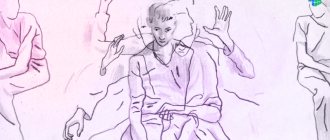Adviсe
- Main signs of Stockholm syndrome
- Who is susceptible to Stockholm syndrome?
- Development of Stockholm syndrome
- Stockholm syndrome in the family
- Everyday Stockholm syndrome: spouses
- Everyday Stockholm syndrome: fathers and children
- Treatment of Stockholm syndrome
- From the history of the concept
This phrase is heard quite often. But not everyone knows what it means. What is Stockholm syndrome? This is a psychological condition where the victim falls in love with his captor . This syndrome is also called Swedish, Munich, Scandinavian, Brussels and Copenhagen syndrome. The main indicator of a person with this syndrome is his interest in the fate of the kidnapper. At court hearings, the victim gives acquittal testimony and demands a reduced sentence. She often hires a lawyer herself, visits her in prison, and performs other similar actions. When hostages protect a terrorist, this is Stockholm syndrome.
Main signs of Stockholm syndrome
During the capture, the victim activates a kind of protective psychological mechanism. She wants to please the criminal and commits actions that are compatible with criminal behavior. This will allow the terrorist to perceive the victim in a positive light and not harm her.
For the victim, release becomes a potentially dangerous event that should not be allowed under any circumstances. The likelihood of getting a bullet in the forehead doubles: either during liberation activities by the police, or from the criminal himself, at a time when he has nothing to lose. Over time, being with the criminal, the victim learns more about him: about his problems, hopes and aspirations. Doubts and thoughts arise that the criminal is actually right, and his actions are correct. The prisoner on a subconscious level is immersed as if in a game, a dream. He accepts the rules of this game. In them, the captors are people who want to achieve justice, and those who rescue the hostages are completely to blame for the situation and what happens to the terrorists and the victim.
Etiology
The causes of the pathology are inexplicable. In the process of long-term communication, the victim and the offender become closer and begin to understand each other. The hostage learns about the life principles and aspirations of the captor, sympathizes and sympathizes with him. He is ready to listen for a long time to complaints about unjust power, stories about bad luck, troubles and blows of fate. This is how the hostage develops an illogical desire to help his own kidnapper. Gradually, the communication of these people moves to a new level, they cease to be enemies, begin to like each other and see kindred spirits in each other. This is how contempt, horror and other negative feelings are replaced in the victim’s mind, which are simply impossible to get rid of in any other way.
Having understood the motives of the invader, the victim agrees with his beliefs and ideas and begins to help the criminal out of fear for his own life. In such cases, the actions of police officers seem no less dangerous than the actions of the invaders. Pathology develops only with loyal treatment of prisoners. Otherwise, the victim develops hatred of the aggressor and fear for his own life.
Conditions necessary for the development of pathology:
- The presence of two sides - the aggressor and the victim,
- Their communication is completely isolated from outsiders,
- Loyal attitude of a terrorist to a prisoner,
- Understanding the actions of the aggressor and justifying them,
- Separating a large group of hostages,
- Replacing the victim's contempt with approval and sympathy,
- Joint achievement of goals in conditions of danger and risk of death.
Factors causing the development of the syndrome:
- Suppressing emotions in hostages by blindfolding, gagging, or frequently changing guards.
- The absence of cruelty, intimidation, and coercion contributes to the emergence of warm feelings.
- Language barrier - the lack of verbal communication complicates the process of forming mutual sympathy.
- Psychological literacy of the parties increases the chances of survival.
- The hostage’s sociability, his openness to communication, and contact make it possible to change the behavior of the hostage.
- Different religious movements and cultural values of the parties can influence the development of the syndrome in different ways - oppress or stimulate corresponding changes in the behavior of the victim, justifying the ruthlessness and ruthlessness of the aggressor.
- The syndrome develops 3-4 days after the active actions of the criminal. During this time, the victim recognizes the aggressor, begins to understand the reasons for the violence and justify the tyrant’s antics.
Who is susceptible to Stockholm syndrome?
Stockholm syndrome comes from childhood. This problem most often concerns people who are disliked by mom and dad . Such a child was not taken into account, constantly snapped at, not perceived as a full-fledged member of the family, beaten and morally oppressed.
The victim tries once again not to say a word against his offender, believing that in this way there will be less aggression on his part. At the same time, violence towards her is perceived as an action that must take place, and cannot be done without it in the current situation. Experiencing torment, both physical and psychological, the victim still justifies the offender.
Still from the film Beauty and the Beast, 2021. Many believe that Belle exhibited Stockholm syndrome towards the Beast.
One of the reasons why a person is susceptible to Stockholm syndrome is previous experience of physical or psychological bullying . The psyche is disturbed, so the subconscious rearranges information in such a way that violence is a necessary punishment for some sins.
Forecast
Recovery is possible only when the victim herself realizes the inferiority of her position and the lack of logic in her behavior, and refuses the role of a lack of initiative person. To achieve success in treatment, it is necessary to constantly be under the supervision of specialists in the field of psychology, psychiatry or psychotherapy. In addition to working with a psychiatrist, patients need the love and support of family members to help them overcome stress and fear.
The prognosis for Stockholm syndrome is favorable. It depends on the qualifications of the psychotherapist and the desire of the victim to be treated. The household version is difficult to correct. This is due to the victim’s reluctance to deal with this problem. In many ways, the outcome of the pathology is determined by the depth and degree of damage to the human psyche.
Development of Stockholm syndrome
This syndrome cannot develop spontaneously out of nowhere; a number of reasons are required for its “activation”:
Being in a confined space with a criminal side by side and one on one. Intense fear of the offender. It seems to the victim that there are no ways of salvation in this situation, and she resigns herself to this state of affairs. After a while, the hostage begins to like the terrorist, and in the end it may happen that the victim falls in love with the maniac. The victim ceases to recognize himself as a person. He completely dissolves in the aggressor, feeling his needs, needs and problems as his own. In this way, the human body adapts to the problem in order to be able to survive in the most difficult and unbearable situation.
Where did it all come from?
From the title it is clear that this incident occurred in Stockholm (Sweden). The Kredibanken bank robbers took four employees hostage: Birgitta Lundblad, Elisabeth Oldgren, Kristin Enmark and Sven Sefström. Over the course of three days, the captor Jan-Erik Olsson and his partner, Clark Wolfsson, who was released at his request, called government officials (in particular, Prime Minister Olof Palme is mentioned) and declared their intention to release the hostages only if certain conditions were met (everything is pretty standard: money, weapons, car).
Three days later, on August 26, 1973, police drilled a hole in the ceiling of the bank building, through which they could observe what was happening inside. Only Jan-Erik Olsson noticed this, promising to deal with the hostages if the police took action. And yet, on August 28, the Swedish police carried out a gas attack, as a result of which no one was injured: the hostages were taken out safe and sound, and the criminals were taken into custody.
What's remarkable about this story? Perhaps the most shocking thing is that the hostages (mostly hostages) themselves hired a lawyer for Olsson and Olofsson [M. Adorjan, T. Christensen, B. Kelly, D. Pawluch, 2012] to protect the “punishers” from the aggressive public and justice. For what?
It turned out that during the course of the hostage-taking operation, the hostages were imbued with real compassion for the criminals and justified them in their own eyes, because they believed that the fault of the unfolding action was not at all in the deviant inclinations of the men, but in the injustice of the society that forced them to commit such an act. Because of this, the hostages did not refuse to testify in court against Olofsson and Olsson. Obviously, the entire public was truly surprised by such a reverent attitude towards the criminals on the part of the hostages.
If you are wondering how the trial ended, we hasten to inform you that Clark Olofsson was released due to the proven attempts to rescue the hostages and the lack of support during the operation of Jan-Erik Olsson. The latter was sentenced to 10 years in prison, and while in prison, he received countless admiring letters from fans. By the way, Olofsson and one of the hostages, Christine Enmark, began to communicate in freedom and became family friends.
During the proceedings, psychiatrist and criminologist Nils Beyerut worked with the police, who became the author of the term “Normmalmstorg syndrome,” which was later transformed into “Stockholm syndrome.” However, long before that, in 1936, Anna Freud, the youngest daughter of the founder of psychoanalysis, Sigmund Freud, who was also considered the founder of child psychoanalysis, essentially introduced this concept under the name “identification with the aggressor” [A. Freud, 1936].
Let's see in what other cases the syndrome manifested itself.
Stockholm syndrome in the family
You see a smiling couple on the street: a young man and woman, they look happy and satisfied with life. However, the first impression is not always true. Often, under the guise of such prosperity, physical or psychological violence within the family is hidden. Everyday Stockholm syndrome in family relationships is not uncommon.
With this disease, the victim does not feel like a victim at all; on the contrary, she remains faithful to her offender, protects him in every possible way and justifies his actions with her past mistakes. Treatment will require the help of a psychiatrist; you cannot cope with this problem on your own. Such things happen not only between husband and wife, but also between parents and their children.
Many women who are beaten by their husbands are susceptible to Stockholm syndrome.
Everyday Stockholm syndrome: spouses
Of course, not everyone knows what Stockholm syndrome is in a family. This phenomenon is not so common everywhere. Domestic violence harms not only the victim herself, but also everyone around her. Close people know about what is happening, but in fact they cannot do anything. The victim falls into deep depression, his will is suppressed, the person loses his “I”.
The most popular and clear example of Stockholm syndrome is the beating of a wife by her husband. It is not clear to those around her that the woman’s position is that she remains close to her husband, continues to live with him, as if nothing was happening. Why is that? Why doesn’t she leave after the first such incident?
Many of them make excuses by saying that they did not know a comfortable life with their husband, children should be raised in a complete family, but what will others say and other similar excuses?
In fact, it is Stockholm syndrome in all its colorful manifestations that affects the mind in a similar way. Only a doctor or strong enough personal motivation can help.
Children growing up in such families become victims a priori. They see a negative connotation in everything, even when the attitude towards them is positive. Such people grow up depressed, looking for constant injustice, which is necessarily directed in their direction.
Stockholm syndrome can occur in children of a parent who suffered beatings
Everyday Stockholm syndrome: fathers and children
In family relationships, children are often susceptible to Stockholm syndrome. Those children who are not the only ones and have other brothers and sisters believe that they are loved less than others; children who are beaten and really disliked and humiliated in every possible way. The situation is complicated by the fact that a child is a small person; he cannot in any way influence the situation and the events that happen to him. Therefore, this disease remains with him until the end of his life. Such a child proves to his parents that he is worthy of their attention, worthy of love and affection, but if his attempts fail, he will begin to think that he is not like everyone else, worse, ugly, stupid, etc.
Treatment of Stockholm syndrome
It is almost impossible for someone suffering from Stockholm syndrome to recover on their own. Therefore, psychiatrists or third-party people who can have the same influence, comparable to the power of influence of that same maniac, should come to the rescue. The main problem of people suffering from this disease is that it is difficult or even almost impossible to convince them that the situation is really out of control, and they are being subjected to cruelty. They continue to look for the cause within themselves, delving into their own heads all day long, going even deeper into yourself. Stockholm syndrome is more common in women than in men . This is due to the emotional state and vulnerable soul of the weak half of humanity.
There is only one way out - the victim must be confident in the future, she must see that life goes on, that there are still some other positive moments in it that are worth being distracted for. This will help you get back on your feet and feel a surge of fresh strength.
Often, treatment does not end after a couple of months of conversation with a psychotherapist; usually it takes years of diligent auto-training and drug treatment. But you shouldn’t stop, each person is a separate independent person who should not be led by anyone else.
Still from the film “V for Vendetta”, 2006. Natalie Portman’s heroine at some point began to sympathize with the kidnapper of “V”
Diagnostic measures
Diagnosis of Stockholm syndrome is based on the results of a psychometric method, which is a step-by-step interview of the patient using clinical test techniques. The psychologist asks the victims questions that help identify deviations in the patient’s mental state. Specialists pay special attention to the emotional state, the presence of phobias, anxiety, signs of maladjustment and derealization. A final diagnosis may require interaction between the doctor and the patient’s family and friends.
From the history of the concept
Nils Biggeroth is the creator of the very concept of “Stockholm syndrome” . The essence and history of the term “Stockholm syndrome” dates back to 1973. Then the terrorists took hostages in the bank and held them at gunpoint for almost a week. At first everything went according to the standard scenario. But later during the siege, the police were shocked when they realized that the hostages were doing their best to protect their offenders, while preventing them from doing their job. What followed was something completely strange. After the terrorists were taken into custody, the hostages demanded amnesty, and one divorced her husband and swore that she would be faithful to one of the hostages, who had recently threatened to kill her. After some time, the two women “victims” became engaged to their offenders. Since then, the syndrome when the victim falls in love with his tormentor is called Stockholm syndrome.
Pathogenesis
The etiopathogenetic mechanisms of this psychological condition are very complex. Modern psychiatrists and criminologists are unsuccessfully trying to determine the main factors leading to the development of such changes in people's behavior.
Stockholm syndrome develops:
- When hostages realize that their captors care about their lives.
- When victims are given the opportunity to realize their desires.
- When psychophysical attachment to the aggressor appears.
- When prisoners begin to please their captors and experience a kind of dependence on them.
Circumstances under which pathology occurs:
- Terrorist acts involving hostage taking,
- Taking military prisoners during hostilities,
- Imprisonment in correctional institutions,
- Formation of socio-political groupings and separate religious associations,
- Implementation of some national rituals,
- Kidnapping,
- Outbreaks of domestic violence.
Hostages interpret the actions of terrorists in their favor, which is due to the lack of self-defense.
The only way to somehow protect yourself is to evoke pity, compassion and tolerance among terrorists. After release, the hostages continue to support the hostages, submit petitions to the authorities for pardon or commutation of punishment, and visit them in correctional institutions. Stockholm syndrome occurs in several stages:
- Development of positive emotions in the victim towards the aggressor,
- Hatred, anger and aggression among terrorists towards government officials,
- Development of positive feelings among bandits towards prisoners.
During an assault or negotiation, law enforcement officers encourage the development of the first two stages of pathology in the victim. This is necessary for the onset of the third stage, in which mutual sympathy arises between the parties. Such processes can increase hostages' chances of survival.








